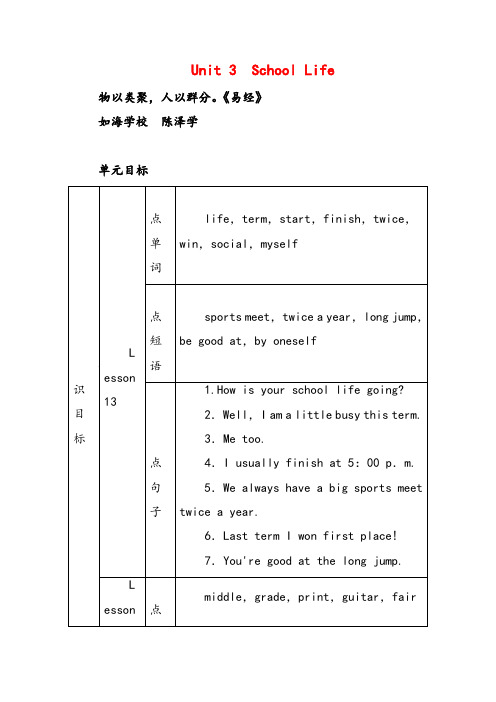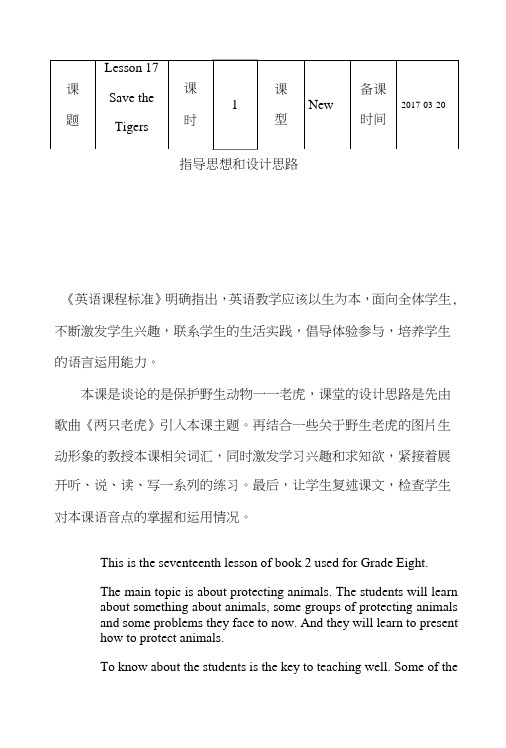冀教版七年级英语unit3教案3
- 格式:doc
- 大小:1.86 MB
- 文档页数:33

本篇文章将为大家介绍教育教案中的一份重要材料——《冀教版小学英语第七册——Unit 3 My Hobbies》的教学计划。
Unit 3 My Hobbies(我的爱好)是冀教版小学英语第七册中的一个单元,该单元主要围绕着“我喜欢什么”这个话题展开,并涉及到许多与课程相关的活动。
此处的教学计划旨在帮助学生更加深入地理解课程内容,并充分利用的各种教学资源,以便使他们掌握课程知识并能够在未来的学习中应用。
一、教学目标1.熟悉课本内容并能够掌握单元内的核心知识和词汇;2.能够用简单的句式和常见的词汇描述自己的爱好;3.学生学会理解和应用课本中的重点短语和句子;4.学生学会写简单的短文以描述自己的爱好。
二、教学内容此次教学的主要内容是理解 Unit 3 My Hobbies 中的所有词汇、短语和句子。
另外,还包括为课程中的相关活动做好准备工作、提供足够的互动机会以及通过参与各种声音交流活动的方式读取短文、朗读词汇和进行互动。
三、教学方法1.教师通过讲述、解读和翻译课本来介绍课程内容,并引导学生练习描述自己的爱好;2.为学生提供多种趣味活动,以便他们能够参与、表达自己的想法和应用所学知识;3.通过让学生使用各种资源进行写作、发音和表达来促进他们对课程内容的理解和应用;4.实施小组活动以促进学生之间的互动和合作。
四、课程步骤1.课前准备:教师根据学生的年龄和兴趣准备好教学资源,包括图片、卡片、录音等,以便介绍新的课程内容。
2.导入:查看之前的课文,回忆学生学过的单元和相关的内容。
教师可以通过介绍一些不同的语境、回顾学生掌握的知识以及给出一些小练习来让学生更好地接受新的知识。
3.知识学习:通过带领学生阅读单元中的词汇、短语和句式,让他们进行口头练习和写字练习,并认真分析和使用这些语言。
4.练习和检查:为学生提供一些有关单元的知识点问题以检验其对知识的掌握程度,让他们进行口头测试以检查其对词汇和语音的掌握程度。
5.课程结束:为提高学生的满意度和自信心,教师可以鼓励学生在下一次课程前进行口头练习,以便后续的课程更加轻松和愉快。

冀教版精品英语资料(精校版)Unit 3 Lessons 13-18 Body Parts and FeelingsLesson 13:Body Parts一、Teaching content:(教学内容)1.Master the following:body,head,eye,nose,mouth,ear,arm,hand,fingers,leg,foot,short,long,part,robot,camera,smell,player,homework.prehend the meaning of text.二、Teaching goals:(教学目标)1. Remember the important words about body parts.2.Understand the meaning of text.3.Sentences:I have ...She/he has...You have...三、Key points:(重点)To know and be able to point out a certain body part.四、Difficult point:(难点)Sentences:I have ...She /he has...You e about have and has.五、Teaching aids:(教学辅助)Recorder, pictures or cards.六、Type of the lesson:(课程类型)Listening and speaking.七、Teaching procedure:(教学过程)Step 1.Warming up.Let some students draw body drawings on the blackboard. Then write the body parts that they have known.Step 2. Lead in.(引入)Learn more new words about your body and write them on the blackboard.Step 3. New lesson.(新课)No. 1 Learn new words:make sure the Ss can read the new words,and understand the words means.No. 2Text:Before the class,read the picture,comprehend the meaning of text.Translate the text first,then repeat it in English,ask the Ss read.Make sure the Ss can read text by themselves.Ask the Ss understand the text,then finfish the homework.No.3Grammar:have/hasI/you/we have... He/she hasPractice for a while. When the students are practicing, the teacher must walk around and find the mistakes that they make.Step 4. Play the tape for the Ss to follow.Step 5.Summary. (小结)Sum up the body parts,distinction have and has how to use it.Step 6. Homework.(作业)Do your excise book.Step 7.Blackboard-writing:(板书)八.Teaching reflection:(教后反思)Lesson 14:Colors and Feelings一、Teaching content:(教学内容)1.To master these words:sad, sick, scared, angry. To understand the following:question.smile,mean.2. some useful patterns:How can you feel a color? Don't be scared!二、Teaching goals:(教学目标)1.to learn how to express the feelings .2.to learn more about the colors.3.to use what was learned in the daily life三、Key points:(重点)The words about feelings: sad, sick, scared, angry.四、Difficult point:(难点)What colors stand for what feelings.五、Teaching aids:(教学辅助)Recorder, pictures or cards.六、Type of the lesson:(课程类型)Listening and speaking.七、Teaching procedure:(教学过程)Step 1.Warming up.Review the words about colors.Step 2. Lead in.(引入)Ask the students questions in the life. You give a student a present and ask his feeling now. Then lead the words:happy, sad, sick, scared, angry.Step 3. New lesson.(新课)No. 1 I feel blue.Li Ming:Hi,Jenny!I am listening to an English song.In the song,the singer says "I feel blue".How can you feel a color?Jenny:That's a good questions.In English,we use many colors for our feelings.Blue can mean "sad".Green can mean "sick".Yellow can mean "scared".And red can mean "angry".Li Ming:Wow!Thank you,Jenny.In China,red is a happy color.No. 2 Sentences:Don't feel bad.Don't be scared.Don't see red.Don't feel sick.Step 4. Play the tape for the Ss to follow.Step 5.Summary. (小结)Sum up the words about feelings,and what colors for what feelings.Step 6. Homework.(作业)Finish the activity book.Step 7.Blackboard-writing:(板书)The words about feelings.八.Teaching reflection:(教后反思)Lesson 15:Tall or Short一、Teaching content:(教学内容)1.master these new words: tall,short.2.to understand these words: Meter, stand, on3. the in-structures : How tall are you? I’m 1.6 meters tall.二、Teaching goals:(教学目标)1.to be able to ask about one’s hight.2.ask the students to do active practice3.Sentences:How tall are you? How tall is she/he?三、Key points:(重点)1.how to say one’s height in English.2.to be able to read the text in the correct tones with the perfect pronunciation.四、Difficult point:(难点)How to read out “3.1 meters , 1.6 meters”. (plural forms of nouns)五、Teaching aids:(教学辅助)Recorder, pictures or cards.六、Type of the lesson:(课程类型)Listening and speaking.七、Teaching procedure:(教学过程)Step 1.Warming up.Learn new word:tall,short,meter,stand ,against,tail,flat,upon,ground.Step 2. Lead in.(引入)Introduce the text first in Chinese,then ask the Ss read the pictures,answer the questions.Step 3. New lesson.(新课)No. 1 Presentationa ruler or some other things while can be used to measure the length, the height, and so on.No. 2 Practice telling one heightAsk the students :1. How tall are you?2. How tall is she/he?3. How tall is your teacher?4. How tall is your friend?Talk about the partner about the subject. Then ask volunteers to come to the front to act the dialogue out.Step 4. Play the tape for the Ss to follow.Step 5.Summary. (小结)Practice the dialogue . Let some students act it out.Step 6. Homework.(作业)Finish the activity book.Step 7.Blackboard-writing:(板书)The important words.八.Teaching reflection:(教后反思)Lesson 16:Happy or Sad一、Teaching content:(教学内容)1.To master these words:happy, sad.To understand the following:very, tired,enough.2. some useful patterns:How do you feel? I feel happy! I’m NOT fine, thanks. Are you tired? No, I’m not. I just feel sad.二、Teaching goals:(教学目标)1.to learn how to express the feeling of sad and happy.2.to learn more about the feelings.3.to use what was learned in the daily life.三、Key points:(重点)How do you feel? I feel happy! I’m NOT fine, thanks. Are you tired? No, I’m not. I just feel sad.四、Difficult point:(难点)Practice the dialogue.五、Teaching aids:(教学辅助)Recorder, pictures or cards.六、Type of the lesson:(课程类型)Listening and speaking.七、Teaching procedure:(教学过程)Step 1.Warming up.Ask the students questions in the life. You give a student a present and ask his feeling now. Then lead the words: happy, sad.Step 2. Lead in.(引入)Before the class,make the Ss understand the followingquestions:1.How does Jenny feel?2.Is Danny hurt?3.Is Danny tired?Step 3. New lesson.(新课)No. 1 Give the presents that you prepared to the s tudents that do well. Then ask “How do you feel?” Explain it in Chinese when it is necessary. Help them answer “I’m happy.” Then take their presents away and ask “How do you feel now?” Help them answer “I’m sad”No. 2Begin “happy, sad” game in pairs, using the presents that we prepared before the class. The best one will get a present.Let’s sing a song together. Listen to the tape and sing happily after it. Encourage students to sing loudly because what we need is a happy feeling. The students can stand up and do according to the text.Step 4. Play the tape for the Ss to follow.Step 5.Summary. (小结)Sum up sentences:How do you feel?Step 6. Homework.(作业)Finish the activity book.Step 7.Blackboard-writing:(板书)八.Teaching reflection:(教后反思)Lesson 17:Seeing a Doctor一、Teaching content:(教学内容)Master these new words and expressions: How do you feel? hurt,stomachache,headache,medicine,have a good rest,see a doctor,have a cold,what's the matter?二、Teaching goals:(教学目标)1.Encourage students to express the uncomfortable feeling.2.Practice the sentences go on:How do you feel? What’s the matter?3.Understand the meaning of text and practice the dialogue.三、Key points:(重点)Help students grasp the expressions to ask and answer the uncomfortable feeling. 四、Difficult point:(难点)Learn the key sentence: What’s the matter? ___ hurt(s). I have a -ache.五、Teaching aids:(教学辅助)Recorder, pictures or cards.六、Type of the lesson:(课程类型)Listening and speaking.七、Teaching procedure:(教学过程)Step 1.Warming up.Let some students draw body drawings on the blackboard. Then write the body parts that they have known.Step 2. Lead in.(引入)Learn more new words about your body and write them on the blackboard.Step 3. New lesson.(新课)No. 1 PresentationListen and repeat the new words. Because some words are hard, we listen and repeat for several times until we can read the words correctly.Point to parts of your body as you and the class say the words.No. 2 Dialogue:1 Are you OK?Jenny:How do you feel,Jim? Are you OK?Jim:See my arm?It hurts.Jenny:It looks bad!Let's go and see a doctor.2.You have a cold.Dr.Green:Hi,Danny.What's the matter?Danny:I feel sick.I have a headache.Dr.Green:Do you feel cold?Danny:Yes!I feel very cold.Dr.Green:Well,let me see...You have a cold.Take this medicine.Stay home and have a good rest.Danny:OK.Thank you ,Doctor Green.Step 4. Play the tape for the Ss to follow.Step 5.Summary. (小结)Sum up the phrases:How do you feel? have a good rest,see a doctor,have a cold,what's the matter?You'd better...Step 6. Homework.(作业)Finish the activity book.Step 7.Blackboard-writing:(板书)The useful phrase.八.Teaching reflection:(教后反思)Lesson 18:We All Look Different一、Teaching content:(教学内容)1.master these new words:hair, has.2.learn and understand these words:different,blond.eful instructions : What does he/she look like? She /he has long/short hair. I have short hair.二、Teaching goals:(教学目标)1.learn to describe the looking of oneself and other students.2.to be able to read the text fluently.3.to write a short passage in English, describe oneself or other people.三、Key points:(重点)How to describe one’s hair, including the length and the color.四、Difficult point:(难点)The verb should be in a special form, such as have and has.五、Teaching aids:(教学辅助)Recorder, pictures or cards.六、Type of the lesson:(课程类型)Listening and speaking.七、Teaching procedure:(教学过程)Step 1.Warming up.Review: Express the feelings of yourself. You can say like this: Are you OK? How do you feel? Let some students answer and ask questions like this.Step 2. Lead in.(引入)Introduce the text in Chinese first.Learn to describe the looking of oneself and other students.Step 3. New lesson.(新课)No. 1 What does he/she look like?(describe people)She is beautiful.He is good-looking.He looks cool!She looks cute!No. 2 We all look different.(have/has)She has short blond hair.He has three black hair.I have short black hair.Step 4. Play the tape for the Ss to follow.Step 5.Summary. (小结)Sentences: What does he/she look like? She /he has long/short hair. I have short hair.Step 6. Homework.(作业)Come to the activity book.Step 7.Blackboard-writing:(板书)The master words.八.Teaching reflection:(教后反思)Unit Review一、Teaching content:(教学内容)1.Words and phrases .2.Key sentences .二、Teaching goals:(教学目标)1. Enable students to use the words and the expressions learned freely.2.Help students grasp the expressions in their daily life.三、Key points:(重点)The words and the expressions in this unit.四、Difficult point:(难点)How to use “have” and “has”.五、Teaching aids:(教学辅助)Recorder, pictures or cards.六、Type of the lesson:(课程类型)Review.七、Teaching procedure:(教学过程)Step 1.Warming up.Review words and expressions in this unit .Step 2. Task:No. 1 Building your vocabulary.Finish the excise on page 46 for remembering more word.No. 2 Grammar in use.(have/has)Practice:Fill in the blanks with have/has.1.May I a pencil,Jenny?2.Danny many yellow shirts.3.You a cold.You'd better go and see a doctor.4.She feels sick.She a stomachache.Step 3. Play the tape for the Ss to follow.Then finish the homework.Step 4.Summary. (小结)Sum up the phrases:play with,listen to,wave one's hand,see red,How tall is she/he? How tall are you? a bit,How do you feel?What's wrong?What's the matter?See a doctor.Are you OK? I have a headache.You'd better ... Have a cold.stay home.have a rest. What does he/she look like? Look different.look cool/cute/funny.Step 5. Homework.(作业)Finish the excises book.Step 6.Blackboard-writing:(板书)Grammar.八.Teaching reflection:(教后反思)。

Unit 3 School Life 物以类聚,人以群分。
《易经》如海学校陈泽学单元目标第一课时Lesson 13 How Is School Going? 课时目标自主学习一、根据句意及汉语提示写出单词。
1.How do you like the life(生活)in America? 2.Do you like social(社会的)studies? 3.Finally,I finish(完成)cleaning my room. 4.They go there twice (两次)a year.5.I will do the work all by myself(我自己).二、写出下列画线短语的汉语意思。
1.We will have a sports meet tomorrow afternoon.运动会2.He went to visit his grandparents twice a year.一年两次3.I am sure I can finish the work by myself.我自己4.I'm not good at singing,but Mary is.擅长教学过程环节1 新课导入教师用PPT快速呈现与学科相关的图片,如英语、数学、历史等,让学生抢答说出图片中指代的是什么学科,并让学生试着造句。
设计意图:通过复习与学科相关的内容自然引出本课时的话题,为接下来的学习做好铺垫。
环节2 新课学习1.教师让学生快速阅读教材第34页的对话,阅读后邀请一名学生说出该对话谈论的主题。
2.教师邀请两名学生分角色朗读对话内容,教师注意纠正学生的发音。
3.教师让学生听对话,并提醒学生注意听其中的学科名词,完成活动1的练习,然后教师核对答案。
4.教师让学生浏览活动2中的五个问题,然后精读对话,完成练习,同时标记出对话中的重要词汇和句型。
教师抽几名学生分享答案,教师点评并核对答案。
5.教师对学生标记出的重要知识点和其他重难点进行讲解(教师可邀请学生试着翻译一些句式较为复杂的句子)。


《英语课程标准》明确指出,英语教学应该以生为本,面向全体学生, 不断激发学生兴趣,联系学生的生活实践,倡导体验参与,培养学生 的语言运用能力。
本课是谈论的是保护野生动物一一老虎,课堂的设计思路是先由 歌曲《两只老虎》引入本课主题。
再结合一些关于野生老虎的图片生 动形象的教授本课相关词汇,同时激发学习兴趣和求知欲,紧接着展 开听、说、读、写一系列的练习。
最后,让学生复述课文,检查学生 对本课语音点的掌握和运用情况。
This is the seventeenth lesson of book 2 used for Grade Eight. The main topic is about protecting animals. The students will learnabout something about animals, some groups of protecting animals and some problems they face to now. And they will learn to present how to protect animals.To know about the students is the key to teaching well. Some of the课 题Lesson 17 Save the Tigers课时1课 型New备课时间2017-03-20指导思想和设计思路students are interested in English. But some dorft like to express themselves in English. So I begin my class with showing beautiful pictures of animals. I think everyone will enjoy them.教学反思优点:在本课的教学中,我坚持在老师的指导下引导学生,创设符合学生生活实际的情景, 让学生枳极地参与到轻松的情境中,在情境中练习并巩固本节课重点,并能用简单的句子做动物保护的报告。

2020学年冀教版英语精品资料Unit 3 Body Parts and FeelingsLesson 13 Body Parts学案编号:15 课型:新授课课时数:1 主备人:李明授课人:李明授课班级:七年级3,4班班级姓名【学习目标】知识目标:1 掌握单词:part , feeling, robot, camera, finger, player, homework, smell2 掌握短语:play with, two big feet, have fun, want to do sth. , do one’s homework, like to play, make noodlesfor you3 掌握句型:①I can smell with my nose . ②They are also my cameras.③I can speak English and Chinese. ④I have two long legs and two big feet.⑤We can be friends. ⑥I can’t do your homework but I can make noodles foryou.能力目标:能够正确地用have来表达“有……”。
情感目标:能够用英语正确地描述自己以及他人长相上的特点。
【学习重点】学习身体部位名称的单词,并掌握含有have的句式。
【学习难点】动词have的基本用法。
【学法指导】 1. 自主学习,并通过熟读课文独立完成相应练习。
2. 课堂探究,针对自主学习过程中的疑难点大胆质疑,教师点拨,学生独立完成导学案。
3. 自主归纳知识点,作好学情反馈。
【预习导学】用括号内所给词的适当形式填空1. Her leg isn’t short. Her leg is (long).2. His hair (be) black and long.3.Their (nose) are very big.4.A desk (have) four legs.5. Our (hair)isn’t the same.【课堂导学合作探究】1. I can see with them. 我能用它们看(东西)。
Part one: Teaching objectives (教学目标):(detailed详备)本单元的话题为“身体部位和情感”,要求能描述某人的外貌特征,会简单地表达自己的情感,写作时往往使用sb. has/hav e..., sb.'s favour ite...等句型,在结尾处对所描写的人物进行评价。
写作时经常会用第三人称或第一人称,时态用一般现在时。
Teaching important points 重点:能描述某人的外貌特征,会简单地表达自己的情感Teaching difficulties难点:使用sb. has/hav e..., sb.'s favour ite...等句型Common test points(常考点):作文Writing Theme(写作主题):身体部位和情感Class hour(课时):1 Repeat lesson preparationPart two: Teaching procedures (教学过程):Repeat lessonStep1: Class opening and reviewpreparation 1.Greetings (Warmup)师生问好Step2: New concepts(detailed详备)(一) 单元话题短语积累1.have fun玩得高兴2.play with和……一起玩3.do one's homework做某人的家庭作业4. listen to听……5.wave one's hand挥手6.see red火冒三丈7.a bit有点儿;稍微8.stand against/upon靠着……站9.think of想起;考虑10. in the sky在天上11. see a doctor看医生12. have a cold感冒13. stay home待在家里14. have a rest休息一下(二) 阅读下面的短文,完成相关的任务。
Unit 3 Body Parts and FeelingsLesson 13 Body Parts 教学设计河北教育出版社出版所用教科书书名所教册次、所教年级七年级七上第三单元单元设计主题Lesson 13 Body Parts1.整体设计思路、指导依据说明这节课主要是学习如何用简单的英语描述外貌特征,以及通过描述身体的各部位进而描述身体各部位的功能。
文章没有用真实的人物,而是用机器人Robot,增强了可读性,学生更容易接受,我在设计本课时,除了用图片及语篇引入新词外,还让学生描述动画片中的形象史莱克,激发他们的学习兴趣。
《新课标》指出:学生通过英语课程能开阔视野,认识世界的多样性,注重语言学习的过程,强调语言学习的实践性,主张学生在语境中接触、体验和理解真实语言,并在此基础上学习和运用语言。
鼓励学生在教师的指导下,通过体验、实践、参与、探究和合作等方式,发现语言规律,逐步掌握语言知识和技能,不断调整情感态度,形成有效的学习策略,发展自主学习能力。
同时对学生进行大量的语言输入,提供丰富的课程资源,创造性得开发和利用英语学习资源,拓展学生学习和运用英语的渠道。
2.教学背景分析教学内容分析:教材第二单元是颜色和衣物,本单元是身体部位和感受,可以用到上一个单元用到的颜色及衣物更清楚准确的描述人物的外貌特征。
而本课主要是研究如何描述人体各部位名称及其功能。
学清分析:七年级的孩子学习英语的积极性很高,而且这篇课文不是很难,主要问题是如何通过多种活动调动学生的多种感官,慢慢形成他们的语篇意识。
3. 学习目标分析1. 通过观察机器人的外部构造,会用英语说出身体部位及五官的名称。
2. 通过介绍身体的部位,正确而灵活使用have/has,并能对自己和他人的相貌进行描述。
3. 在小组活动中,积极与他人合作,互相帮助,体会英语学习中的乐趣,遇到困难时,能主动请教,勇于克服困难。
4.教学重点、难点分析教学重点:part, feeling, robot, camera, smell, finger, player, homework, play with用简单的英语描述外貌特征。
教学难点:用I have .... I can do ... with my ...较为流畅地描述外貌特征。
5.教学过程设计Step 1 Greetings:Greet the studentsStep 2 Warm-up: Brainstorm:Write down as many words about body part and actions as they can. (写出关于身体部位、动作的词汇)[设计思路:利用头脑风暴让学生以最短的时间写出关于身体部位和动作的词汇,利于后面的新知学习。
]Step 3 Learn the new words.Show the students some pictures and sentences and help them grasp the new words.(设计意图:通过图片展示新词,突出重点、突破难点;通过语篇进行解释,使学生利用语境记单词和短语的含义。
)Step 4 Remember the new words as quickly as possible. Then fill in the blanks with the new words and expressions.Ask the students have a competition, see which student can remember the most new words. [设计思路:通过竞赛激发兴趣,通过展示音标帮学生正音。
通过趁热打铁及时练,掌握新词汇,为新授课打基础。
]Step 5 Listen and answer the questions:1. Who is Robin?2. Can Robin speak English and Chinese?3. What does Danny want Robin to do?[设计思路:锻炼学生通过听力捕捉重要信息的能力。
]Step 6 A Game: Read the text in group of four and try to ask more questions.[设计思路:通过合作学习培养学生的合作意识,通过自己提问题,培养学生用英语做事情的能力。
] Step 7 Label Shrek's body parts.Describe his body parts.eg. He has two big ears. He use them to hear the songs of the birds.[设计思路:通过让学生把史瑞克的身体各部位名称进行标签,然后描述身体的各个部位,让学生初步了解如何描述身体部位。
]Step 8 Guessing gameFirst, describe a person, then let others guess who he/she is.[设计思路:通过一个同学的描述,让学生猜测这个人是谁,培养学生集中注意力捕捉英语信息的能力。
激发学习兴趣。
]Step 9 Listen to the song Hokey Pokey and do the actions.Put your right hand in.Take your right hand out.Put your right hand in,And shake it all about.Do the Hokey Pokey, And turn around. That’s what it’s all about.[设计思路:通过唱歌、动作,培养学生的口、手、脚的协调能力,巩固新知。
]Step 10 Dig in1. Eye for eye and tooth for tooth.以牙还牙,以眼还眼。
2. He has a green thumb.他有特殊的园艺才能。
3. Tom likes to talk with others face to face.汤姆喜欢面对面地与别人交谈。
4. My father and I see eye to eye on the problem. 我和我爸爸在这个问题上看法一致。
[设计意图:通过知识拓展,开拓学生视野。
]Homework:Read the text and write a passage named “My body parts”.Collect more words and expressions about body parts.Read the passage “What is the most important part” and find good sentences.6.教学评价设计Self-evaluation(自我评价):1. 我能够听懂本课语段,识别主题并获取主要信息。
☆☆☆☆☆2. 我能就本课话题进行简单地交流和书面表达。
☆☆☆☆☆3. 我能够勇敢地表达自己的观点。
☆☆☆☆☆4. 这节课我很快乐。
☆☆☆☆☆《新课标》指出:英语课程评价体系要有利于学生综合语言运用能力的发展,采用多元化的评价方式,所以注重形成性评价,鼓励学生开口说英语,同时最后的自我评价,使学生了解本课的学习效果。
7.教学反思本课的教学调动学生的多种感官,让学生动口、动手、动脑,使不同学习类型的学生都有所收获。
再通过头脑风暴、小组活动、猜谜游戏、歌曲等等活动激发学生的学习兴趣。
通过拓展扩大学生的知识面。
Lesson 14 What Makes You Unique? 教学设计河北教育出版社出版所用教科书书名所教册次、所教年级七年级七上第三单元单元设计主题Lesson 14 What Makes You Unique?1.整体设计思路、指导依据说明这节课主要谈论感受,但是本课有个很好的切入点,就是用蓝色来谈论伤心、绿色谈论生病的、黄色谈论害怕、红色谈论生气,这样学生就能有兴趣学习。
所以在该课的设计上我也力求体现新颖,拓展部分用了表示颜色的词的固定用法。
同时这课还有一个点,就是文化渗透,红色在中国是幸运色。
这点不能忽视。
《新课标》指出:学生应该有较为明确的英语学习动机和积极主动的学习态度。
能就有关熟悉的话题陈述并参与讨论;能就日常生活的各种话题与他人交换信息并陈述自己的意见。
这个感觉的话题就是日常生活中的话题。
2.教学背景分析教学内容分析:本课是在学完了上一课描述外貌特征之后继续描述人的感觉、感受的文章,出现了四个表示颜色的词汇在英语表达感受的不同,之后又讲了红色在中国是喜庆的颜色,所以要注意中西方文化的渗透。
文化小贴士又补充了白色的含义。
学清分析:颜色对于七年级学生来说并不陌生,但是用颜色表达感受就是新鲜的了,学生会很感兴趣,这是一个很好的切入点,就是以头脑风暴让学生总结颜色和感受的词汇引入,然后再环环紧扣,步步深入学习该课内容。
3. 学习目标分析1.帮助学生了解不同的颜色如blue/ green/ yellow/ red表达的感情色彩,并会用see red等表达自己的情感。
学生在本课结束时能够掌握黑体词的用法及短语句型的用法,并了解三会词。
2.帮助学生了解生活中如何用英语表达自己的感受。
3. 提醒注意了解自己学习中的进步与不足并积极赶紧。
4.教学重点、难点分析教学重点:1. 词汇:question, sick, smile, mean短语和句型:listen to...; wave one's hand; see red2. 用英语较为流畅地表达自己的感受。
教学难点:用正确恰当的方式表达自己的感受,并能适当调节。
5.教学过程设计Step 1 Greetings:Greet the studentsStep 2 Warm-up: Brainstorm:Write down as many words about colours and feelings as they can. (写出关于颜色、感觉的词汇)[设计思路:利用头脑风暴让学生以最短的时间写出关于yyan颜色和感觉的词汇,利于后面的新知学习。
]Step 3 Learn the new words.Show the students some pictures and sentences and help them learn how to use the words and phrases correctly and freely.singer [ˈsɪŋə]] n. 歌手Michel Jackson is one of my favorite singers. He sang a lot of songs, like The earth song, Thriller, We are the World and so on.feeling [ˈfi:lɪŋ] n 感觉;情感(常用作复数)—What’s your feeling?—I feel hot and I want to eat an ice cream.question[ˈkwestʃən] n. 问题The girl wants to answer the teacher’s question. She is really active.sick [sik] adj. 病的;生病的The child feels sick. He has a bad stomachache.scared [skeəd] adj. 恐惧的---What are you scared of?---I’m scared of scary animals.smile [smail] n. &v. 微笑A girl shows a board with a smiling face during an activity to celebrate the upcoming World Smile Day at No.10 Middle School in Xingtai, north China's Hebei Province, May 7, 2009. The World Smile Day falls on May 8. (Xinhua/Chen Lei)wave[weiv] v. 挥手;招手Santa Claus is waving his hand to us. He is saying hello.mean[mi:n]] v. 意思是adj.刻薄的1. What do you mean by saying that?2. Don’t be so mean to others, or you’ll lose friendship.* What’s the meaning of this word?(设计意图:通过图片展示新词,突出重点、突破难点;通过语篇进行解释,使学生利用语境记单词和短语的含义。